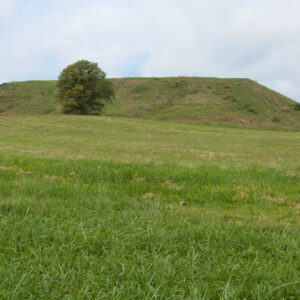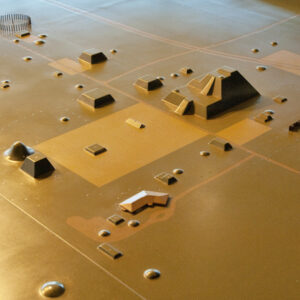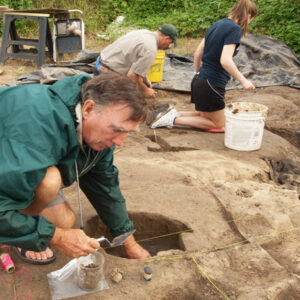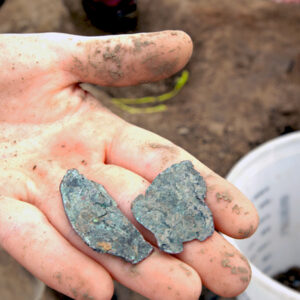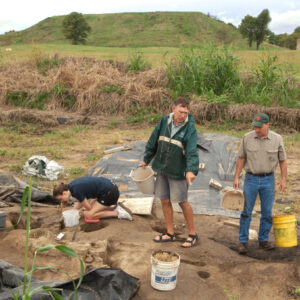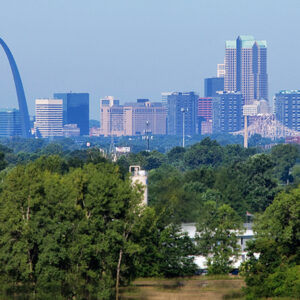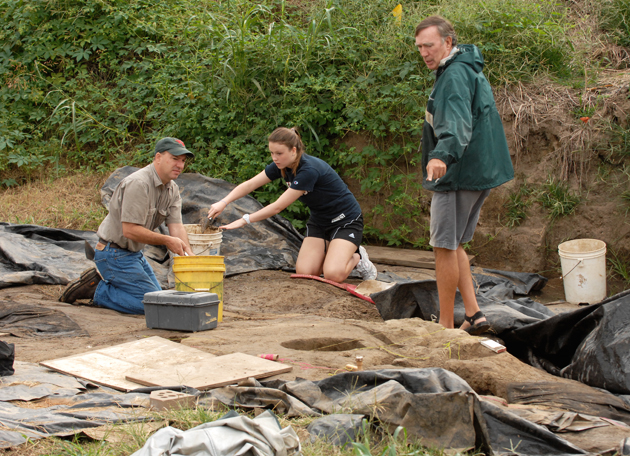
It’s a crisp October morning in the Midwest. Impending rain hovers in the air. You stand knee-deep in prairie grass taking in the scene. To the north, a multitude of cars scurry on an interstate in the distance. An aged trailer park dots the landscape’s horizon to the east. Turning south, another well-used road unceremoniously slices through the middle of a vast expanse of land. To the west, though, an earthen structure rises 100 feet toward the sky. At this sight, you start to reflect on the civilization that once ruled this area.
You can hear the clicking of crickets but very little else. Yet just beyond the earthen lip to your right, under what was formerly Mound 34, an instructor and two students work diligently some 4 to 5 feet below the ground’s surface. In a pit, approximately 40 by 40 feet, archaeologist John Kelly, PhD, doctoral candidate Tim Schilling and freshman Grace Niswander quietly wield metal trowels and sift through layers of dirt. Their deliberate movements yield small progress, but their patient hands continue the search. They seek clues to the people that inhabited this space 600 to 1,000 years ago.
“Mound 34 is not a burial mound,” he says. “It has a building underneath it, which I think is the ancestral building for the mound. So while we focus on the mounds, the history’s really about the building that was there before the mound!”
Mound 34 is only one of the many at Cahokia Mounds (http://cahokiamounds.org/) — the largest pre-Columbian Indian site north of Mexico. The abandoned community at one time featured some 4,000 acres and more than 100 mounds. The State of Illinois now protects 2,200 of these acres and 70 of the remaining 80 mounds. In 1965, the site received National Historic Landmark status and in 1982 a UNESCO World Heritage Site designation.
Located just minutes east of downtown St. Louis, Cahokia Mounds beckons visitors to explore its wonders and to mull over the prospect of a once-thriving city and native society. The society’s disappearance some 600 years ago, due to a combination of climate changes and geopolitical dynamics, also leaves much for students of history to ponder. And Washington University students, faculty and alumni have been doing so — conducting research at Cahokia and its satellite towns, villages and farmsteads — for decades. Kelly, in fact, has been at it for some 40 years, 13 of these at Mound 34 alone.
“We’re underneath the mound here,” Kelly says. “The top is off, and the area where we’re standing was excavated back in 1956. We’ve been working here the last several years to re-map the area in a much-more detailed way.”
According to Kelly, outside of burial mounds, some precipitating event probably took place in the life of an individual or a building for it eventually to be removed and buried under earth, and then made into a raised platform — a mound — upon which a new building could be erected.
“Mound 34 is not a burial mound,” he says. “It has a building underneath it, which I think is the ancestral building for the mound. So while we focus on the mounds, the history’s really about the building that was there before the mound!”
Burned soil and residue from fire indicate the building had a hearth in the middle, and residue from copper suggests a workshop to the side. Evidence also suggests that the building hosted a particular group, a sodality, focused on a particular mission or purpose — in this case, probably hunting or warfare. During previous excavations in 1950 and 1956, researchers found marine shells, shark’s teeth and arrow points, numerous animal bones, as well as serving vessels — all part of hunting and warfare rituals.
Strangely, similar shell cups were found at a site in eastern Oklahoma, which dates to a period shortly after the demise of the Cahokia society. The shells evoke a possible migration or passing down of heirlooms. Since the Mound Builders kept no written records, researchers of these areas often find more questions than concrete answers.
The center of civilization
Doctoral candidate Tim Schilling focuses on the mysteries of Monks Mound — the stately mound west of Mound 34. Monks Mound is the largest flat-topped, pyramidal earthen structure in North America. Constructed between about 1000 and 1200 A.D., it measures more than 1,000 feet long by 800 feet wide, and it may include up to four terraces. Rising 100 feet, the mound lies at the center of the Cahokia site.
“At one point, the ancient Cahokians placed a large post through the upper surface of Monks Mound,” Schilling says. “The post was more than 40 feet tall with a diameter of 3 feet. Erected at the top of the mound, the post may have been an axis mundi or the center of the Cahokian world.”
According to Schilling, the native people believed they existed in a universe including an Above World and a Below World, where humans lived at the intersection of these two. He thinks the pole at the top of Monks Mound would have connected the multiple worlds of the ancient Cahokians.
Other structures at Cahokia Mounds also reveal a strong belief in the connection between the heavens and Earth. For example, west of Monks Mound is Woodhenge. One function of Woodhenge may have been to mark astronomical events, such as solstices and equinoxes. Solar alignments observed at Woodhenge, which is constructed of timber logs, can predict the changing of the seasons. At the same time, Woodhenge, one of four or five such structures found at Cahokia Mounds, may have served to channel the power of the heavens to important rituals that took place at the site.
Tracing connections
West of Woodhenge and beyond the borders of Cahokia Mounds, researchers have found evidence of other mound societies in East St. Louis and across the river in the city of St. Louis. In fact, St. Louis was once known as “Mound City,” long before Eero Saarinen’s Arch appeared on the scene, along with the nickname “Gateway to the West.”
“We have a program initiated in East St. Louis,” Kelly says, “and we’re trying to preserve what’s left of the site there.” [Most of what was built in St. Louis no longer exists, except as fill underneath downtown skyscrapers.]
Kelly hopes to introduce his students not only to the society that reigned at Cahokia Mounds, but also to what it was like to travel between the communities to the west. To this end, early in the fall semester, he and students from his freshman seminar walk the six miles from East St. Louis to Cahokia Mounds.
“The students get an appreciation for how people live today, as well as for how they were connected in the past,” Kelly says. “Actually, we’ve got a trail designated now — the Mounds Heritage Trail — that helps detail these lessons.”
When completed, the Mounds Heritage Trail will start in St. Louis, north of the Arch where a mound group was, join the trailhead of the Riverfront Trail, go across the Eads Bridge through East St. Louis and on to Cahokia Mounds. Another leg extends south past the Anheuser-Busch brewery to the Sugar Loaf Mound (located along I-55), which was recently purchased by the Osage nation.
“In the past, you could travel between the communities in one of two ways,” Kelly says. “You could walk, or you could take a dugout. And, well, the dugouts are kind of hard to use now on the interstate.”
For more information on Cahokia Mounds and the research being conducted there, visit http://cahokiamounds.org/,
http://anthropology.artsci.wustl.edu/kelly_john, www.powellarchaeology.org/,
Terri Nappier is editor of this magazine.
